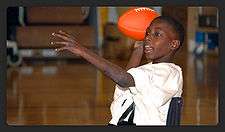Wheelchair Football (American)
Wheelchair Football is a fast-paced sport that is best played when athletes are in maximum physical condition, and at the top of their game in teamwork, strategy and wheelchair-handling skills for both manual wheelchair and power wheelchair users. In 2020, the USA Wheelchair Football League was launched by Disabled Sports USA, in partnership with the Bob Woodruff foundation and National Football League, and is launching in Chicago, Los Angeles, Phoenix and Kansas City, Missouri. [1]
 Boy playing on an American Wheelchair Football Team. | |
| Highest governing body | American Association of Adapted Sports Programs |
|---|---|
| First played | Atlanta, Georgia, USA |
| Characteristics | |
| Contact | Contact |
| Team members | 6 or more (6 at a time during game) |
| Mixed gender | Yes |
| Type | Indoor |
| Equipment | Football, manual wheelchair, and power wheelchair |
History
The sport of wheelchair football was developed for interscholastic competition by the American Association of Adapted Sports Programs (AAASP) of Atlanta, Georgia, USA, to incorporate both the manual and power wheelchair during game play. Wheelchair football is patterned after American football, and is thus different from Powerchair Football or Wheelchair soccer (both adaptations of association football).
Rules
The game of wheelchair football is played on a standard basketball court — 28 metres (92 ft) long by 15 metres (49 ft) wide. The required court markings are a center line and circle, and a key area measuring 8 metres (26 ft 3 in) wide by 1.75 metres (5 ft 9 in) deep at each end of the court. It can be played either indoors or outside, as long as it meets the standard requirements.[2] All athletes must use either a manual or a power wheelchair when competing in the sport.
Specified rules for manual and power wheelchair users
| Players Using Manual Wheelchairs | Players Using Powerchair Wheelchairs |
|---|---|
Players in manual chairs have successfully tackled an opponent when they tag the opponent with two hands on the body and above the knees. |
Players in power chairs will have made a successful tackle when they tag the opponent with one hand on the opponent’s body or chair. |
Classification
Adaptive football players are classified into three different levels, and the rules of play are slightly different for each level.
- Level 1 players: have full use of their arms, hands and eyes.
- Level 2 players: have limited arm and/or hand movement and may have some type of visual impairment.
- Level 3 players: have no arm-movement capability and/or have limited sight.[3]
The rules for Level 1 players are somewhat similar to "touch football," where players touch rather than tackle their opponents. In that adaptive game, the player - and not his or her chair - must be touched to count as a tackle. Players who have limited or no mobility in their arms use chair-to-chair contact for blocks and tackles.[3]
Scoring
Level 1 players, kick offs, punts, runs, and goals are all scored using the hands. Level 2 and 3 players, points for pass completion are awarded if the ball hits the player in the area between the hands and their elbows.
Although the players cannot grab the football, they still need to maneuver their wheelchairs so they can be in the right position for the ball to hit the right place to score. [3]
Team rules
A team has six attempts to score once they receive the ball. Teams may pass or “run” the ball into the end zone. Field goals, kick–offs and punts are thrown. A running game clock (no time–outs for incomplete passes, etc.) is used, as well as a play clock. Scoring is the same as in stand–up football, with one exception. A team that passes for the point–after–touchdown (PAT) will receive two points. Field goals are scored when the ball is thrown through the first two vertical uprights that support the hanging basket.
Basic rundown of the sport
| Team | Number of players | Kick off | Offense | Play clock | Half time |
|---|---|---|---|---|---|
| Varsity teams | Six players per side | made from behind the goal line | 4 downs to reach 1st marker or score | 35 seconds | Two 30-minute halves running clock |
| Junior varsity teams | Six players per side | made from behind the first down marker | 4 downs to reach 1st marker or score | 45 seconds | Two 30-minute halves running clock |
See also
References
- "NFL helping launch of wheelchair football league at draft". ABC News. Retrieved 2020-04-23.
- "Wheelchair Football: World's Most Inclusive Sport". Retrieved 2012-09-11.
- "Wheelchair Football". mobility-advisor.com. Sowder Group LLC. Retrieved 2 May 2018.